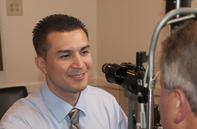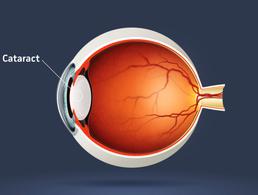15925 E. Whittier Blvd. Whittier, CA 90603
1 block East of the Whittwood Town Center
CATARACTS AND CATARACT SURGERY
What are common symptoms?
Cataracts are found to a greater or lesser degree in up to 65 percent of persons in their sixties and in over 80 percent of persons age 70 and older.
Common cataract symptoms include:
- Blurred vision
- Double vision
- Less vivid colors
- Sensitivity to light, or glare
- Decreasing ability to see street signs, drive at night, read, or do close-up work
- Frequent changes in eyeglass prescriptions
These symptoms may vary depending on the size and location of the cataract. A cataract on the outer edge of the lens may hardly be noticed, but if the cataract is located near the center of the lens, it usually interferes significantly with clear eyesight.
Copyright 2011: Marshburn Eye Center. Eye Doctor Orange County. All rights reserved.
15925 E. Whittier Blvd. Whittier, CA 90603 (562) 947-8681
(562) 947-8681
Excellence in Eye Care for over 50 years
What kinds of lens will be used to replace the cataract?
The technology in lens implant replacement designs over the past decade is unsurpassed in both safety and options. These new generation of lenses offer correction for distance, intermediate, and near vision. Our doctors will discuss with you which lens implant would best suit your particular vision needs and condition. Lens implants are now available to restore focusing, correct astigmatism, and allow a “multifocal" lens option.
Here is a brief description of these state-of-the-art lenses. Dr. Marshburn & Dr. Chhadva will discuss with you if you are a candidate for one of these lenses:
- Toric Lens: This lens implant can correct most levels of astigmatism. Patients for whom this lens is indicated have a 97% likelihood of not needing glasses for distance correction.
- Multifocal or Extended Depth of Focus Lens: This lens has the highest level of glasses independence because it reliably allows for both near and distant vision. Majority of patients with this lens in both eyes do not wear glasses for any purpose.
What can I expect from the surgical experience?
Once you have decided to have your cataract removed, our office will schedule an appointment for the procedure at your convenience. Our doctors perform cataract surgery at a state-of-the-art outpatient facility near the office.
On the day of the procedure, anesthetic eye drops will be used prior to surgery to eliminate any discomfort, and an IV will be placed to administer additional relaxing medication. The procedure itself lasts approximately ten minutes, and you will return home the same day, free to engage in normal activities the next day.
You will visit our office the day following surgery so our doctors can examine your eye and check your vision.
After cataract surgery, what can I expect?
Following their cataract removal, our patients experience clearer vision, more vivid colors and renewed enjoyment of everyday activities such as reading, driving, working, and hobbies.
Cataract surgery is a highly successful procedure. Of the 2 million individuals who undergo cataract surgery every year in the United States, 95% experience a markedly significant improvement in vision.
Will cataract surgery reduce my dependence on glasses or corrective lenses?
New advances in intraocular lens technology have allowed patients who were previously very dependent on glasses to reduce or, in some cases even eliminate, the need for glasses.
Angela Cuadra, our Surgery Coordinator, will provide you with everything you need to know about your surgery and answer any questions you may have about the procedure.
Certified Ophthalmic Medical Technologist Gabriel Raygoza is trained in performing specialized testing that helps to identify cataracts.
A cataract is a clouding of the normally clear lens of the eye. Imagine the eye functioning like a camera: the lens focuses light on the retina at the back of the eye to produce a sharp image. Ideally the lens is clear, but as we age it yellows and begins to harden. When a cataract forms, the lens becomes cloudy like a frosted window and light cannot clearly be transmitted to the retina. The result is impaired vision.
Although most cataracts are caused by normal aging of the eye, there are other causes of cataract formation. These include hereditary factors, metabolic conditions (such as diabetes), the use of corticosteroids, or an eye injury.
What is a Cataract?
At Marshburn Eye Center, our eye doctors will be sure to answer your questions and help you understand what's best for your vision.
What is the treatment for cataracts?
The only safe and successful treatment for cataracts is surgical removal of the clouded lens. Once the focusing lens clouds, it must be removed and replaced in order for clear vision to be restored.
When should I have a cataract removed?
The time to consider cataract surgery is when you are no longer satisfied with the quality of your vision. Although the mere presence of a cataract is not necessarily an indication for surgery, a cataract may be removed any time your ability to function normally is impaired by poor vision. Therefore, if a cataract has caused enough of a loss of sight to interfere with work, hobbies, or lifestyle, it is probably time to consider removal. Our doctors will discuss these issues with patients and together they will decide when cataract surgery is desirable.
Are lasers used to remove cataracts?
Lasers cannot remove a cataract; however, they are used to prepare the clouded lens for easier, safer removal. The laser can create incisions, create an opening through with the cataract is removed, and soften the cataract so less energy is needed. This laser can also treat small amounts of astigmatism.
How is a cataract removed?
Cataracts are removed using ultrasound energy, through a small incision made in the cornea. Once the cataract is removed, it is replaced with a clear intraocular lens.













